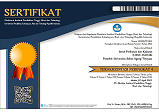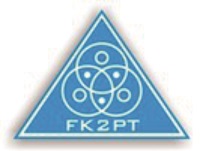Analysis of The Shark Fisheries Sustainability in Cilacap Regency, Central Java
Abstract
Keywords
Full Text:
PDFReferences
Alder J, Pitcher TJ, Preikshot D, Kascchmer K, Ferris B. 2000. How Good is Good?: A Rapid Appraisal Technique for Evaluation of The Sustainability Status Of Fisheries of The North Atlantic. Fish. Cent. Res. Rep. 8(2):136-182.
Ayotte L. 2005. Sharks-Educator’s Guide. 3D Entertaintment ltd. and United Nations Environtment Program.
Blaber SJM, Dichmont CM, White W, Buckworth R, Sadiyah L, Iskandar B, Nurhakim S, Pillans R, Andamari R, Dharmadi, Fahmi. 2009. Elasmobranchs in Southern Indonesia Fisheries: The Fisheries, the Status of the Stock and Management Options. Rev. Fish Biol Fisheries. 19:367-391.
Charles AT. 2001. Sustainable Fishery Systems. UK: Blackwell Science Ltd. 370 pp.
Dharmadi, Triharyuni S, Rianto J. 2010. Hasil Tangkapan Cucut yang Tertangkap dengan Jaring Insang Tuna Permukaan di Perairan Samudera Hindia. Jurnal Penelitian Perikanan Indonesia. 16 (4):285-291.
[DJPT] Direktorat Jenderal Perikanan Tangkap. 2017. Statistik Perikanan Tangkap Indonesia Menurut Provinsi Vol. 17, No. 1. Jakarta: Kementerian Kelautan dan Perikanan.
Fahmi dan Dharmadi. 2013. A Review of The Status of Shark Fisheries and Shark Conservation in Indonesia. Jakarta: Direktorat Konservasi Kawasan dan Jenis Ikan, Kementerian Kelautan dan Perikanan.
Fahmi dan Dharmadi. 2015. Pelagic Shark Fisheries of Indonesia’s Eastern Indian Ocean Fiheries Management Region. African Journal of Marine Science. 37(2):259-265.
Fauzi A dan Anna S. 2002. Evaluasi Status Keberlanjutan Pembangunan Perikanan: Aplikasi Pendekatan Rapfish (Studi Kasus Perairan DKI Jakarta). Jurnal Pesisir dan Lautan. 4(3):43-55.
Gilman ES. 2011. Bycatch Governance and Best Practice Mitigation Technology in Global Tuna Fisheries Shark Interactions in Pelagic Longline Fisheries. Marine Policy. 35: 590–609.
Hermawan M. 2006. Keberlanjutan Perikanan Tangkap Skala Kecil (Kasus Perikanan Pantai di Serang dan Tegal) [DISERTASI]. Bogor: Sekolah Pasca Sarjana. Institut Pertanian Bogor.
Hertuti D. 2013. Analisis Ikan Hiu Tangkapan dan Pola Pemanfaatannya di PPI Tanjung Luar Kabupaten Lombok Timur Nusa Tenggara Barat [TESIS]. Depok: Fakultas Matematika dan Ilmu Pengetahuan Alam, Universitas Indonesia.
King M and McIlgrom A. 1989. Fisheries Biology and Management of Pasific Islands Student. Australia: International Development Program of Australian Universities and Colleges.
Lack M and Sant G. 2006. Confronting Shark Conservation Head On!. Cambridge: TRAFFIC International. iv+29 hal.
Lack M and Sant G. 2011. The Future of Sharks: a Review of Action and Inaction. TRAFFIC report. Cambridge: TRAFFIC International and the Pew Environment Group.
Monintja DR dan Poernomo RP. 2000. Proposed Concept for Catch Policy on Shark and Tuna Including Bluefin Tuna in Indonesia. Makalah disampaikan dalam “Indonesian-Australian Workshop on Shark and Tuna”, Denpasar, Maret tahun 2000.
Mulyana R. 2012. Sistem Pengelolaan Industri Perikanan Tangkap Terpadu di WPP Laut Arafura [DISERTASI]. Bogor: Sekolah Pasca Sarjana, Institut Pertanian Bogor.
Pitcher TJ dan Preikshot D. 2001. RAPFISH: A Rapid Appraisal Technique to Evaluate The Sustainability Status of Fisheries. Fisheries Research. 49:255-270.
[PPS Cilacap] Pelabuha
n Perikanan Samudera Cilacap. 2018. Tabel Statistik Perikanan di PPS (Pelabuhan Perikanan Samudera) Cilacap. Jawa Tengah: Kementerian Kelautan dan Perikanan.
Priono BE. 2000. Sharks, Seabirds and Exces Fishing Capacity in the Indonesia Waters. Makalah disampaikan dalam “Indonesian-Australian Workshop on Shark and Tuna”, Denpasar, Maret tahun 2000.
Purnomo A, Taryono H, Hasution Z dan Hartono TT. 2002. Analisis RAPFISH Perikanan Selat Sunda (Laporan Teknis). Jakarta: Pusat Riset Wilayah Laut dan Sumberdaya Non-Hayati. Badan Riset Kelautan dan Perikanan, Kementerian Kelautan dan Perikanan. 189 hlm.
Rangkuti F. 2004. Analisis SWOT Teknik Membedah Kasus Bisnis. Jakarta: PT. Gramedia Pustaka Utama.
Walker TI. 2005. Management Measures. Dalam: Musick JA dan Bonfill R, editor. Management techniques for elasmobranch fisheries. Rome: Food And Agriculture Organization of The United Nations.
White WT, Last PR, Stevens JD, Yearsley GK, Fahmi, Dharmadi. 2006. Economically important sharks and rays of Indonesia. Australia: ACIAR. 338 hlm.
Widodo J. 2000. The Indonesian Shark Fisheries: Present Status and the Need of Research for Stock Assessment and Management. Makalah disampaikan dalam “Indonesian-Australian Workshop on Shark and Tuna”, Denpasar, Maret tahun 2000.
Zainuddin IM. 2011. Analisa Pengelolaan Perikanan Berbasis Ekosistem (Ecosystem Based Fisheries Management) pada Perikanan Hiu di Indonesia [TESIS]. Depok: Fakultas Matematika dan Ilmu Pengetahuan Alam, Universitas Indonesia.
DOI: http://dx.doi.org/10.33512/jpk.v9i1.7070
Refbacks
- There are currently no refbacks.

6.png)
7.png)




_-_Copy1.png)
